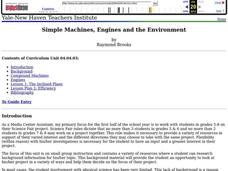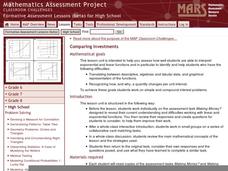EngageNY
Why Do Banks Pay YOU to Provide Their Services?
How does a bank make money? That is the question at the based of a lesson that explores the methods banks use to calculate interest. Groups compare the linear simple interest pattern with the exponential compound interest pattern.
West Contra Costa Unified School District
Interest and the Number “e”
Make a connection between different types of interest and how they are calculated! This algebra II lesson progresses from simple interest to compound interest to continually compounded interest. Formulas are developed rather than given,...
Curated OER
M & M Interesting
Students compute and collect interest payments in the form of M&M candies. In this mathematics instructional activity, students work in small groups to compute either simple or compound interest. They compare the growth of their...
Curated OER
Introduction to Earning Interest: What are APR and APY?
Students explore saving and investing money. In this middle school personal finance lesson, students define and use investment vocabulary, explore compound interest and its effect of savings, and compute simple and compound...
Curated OER
Interesting Interest Rates
Your young bankers compare earning interest accumulated yearly and monthly to decide which method most increases their balance. Using an exponential function to model the bank balance affords the learners more practice connecting...
Curated OER
Simple Machines, Engines and the Environment
Fourth graders calculate the mechanical advantage of an inclined plane. In this physics lesson, 4th graders identify the different types of simple machines and their uses. They give examples of compound machines.
Curated OER
Comparing Investments
Money, money, money. A complete lesson that makes use of different representations of simple and compound interest, including written scenarios, tables, graphs, and equations to highlight similarities and differences between linear and...
Curated OER
Conditional Probability and Probability of Simultaneous Events
Your statisticians examine the characteristics of conditional probability and the probability of simultaneous independent events. They perform computer activities to find probabilities for simple compound events. They examine the...
Curated OER
Integer Solutions to Inequality
When is the last time you assigned your students only one problem? This seemly simple problem requires learners think like a mathematician and reason about how to solve this compound inequality in one variable. More than just using...
Curated OER
# 03 Laboratory Ventilation and Risk Assessment Exercise
Students are introduced to the analysis of health risks in the laboratory, particularly from vapors from organic solvents. They consider quantitative measure of risk such as threshold limit values (TLVs), the amount of the compound that...
Curated OER
Discovering Math Concepts in Business Mathematics, Economics, and Finance
Explore the concept of money and research its origin. There are many concepts related to business math, thusly, there are many formulas used to make calculations around money. Exchange rates of money in different countries, interest,...
Achieve
False Positives
The test may say you have cancer, but sometimes the test is wrong. The provided task asks learners to analyze cancer statistics for a fictitious town. Given the rate of false positives, they interpret the meaning of this value in the...
Curated OER
Tree Identification
Students are introduced to the characteristics of trees and different techniques to identify them. They distinguish between a deciduous and a coniferous tree. Students describe at least four characteristics used to identify trees. They...
Curated OER
Finding and Measuring What You Can't See
Students determine how scientists measure pollutants in food and the environment. Students discover how scientists remove one material based on its physical properties. Students figure out how much of a pollutant is present after...













